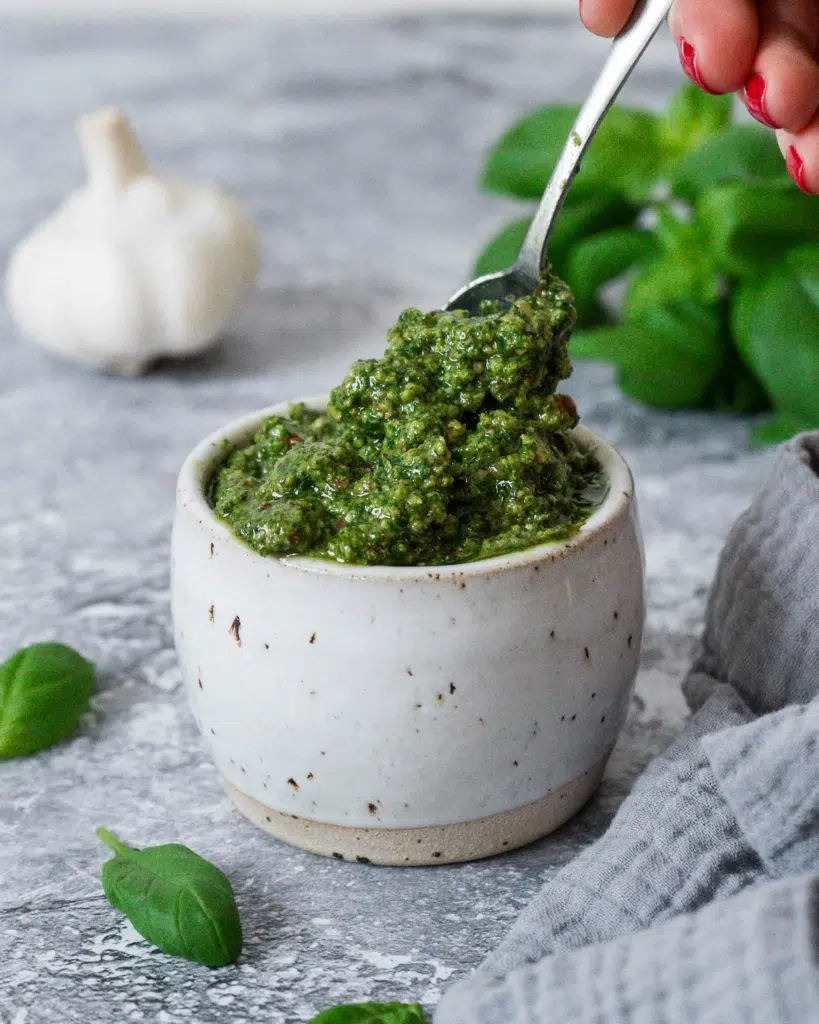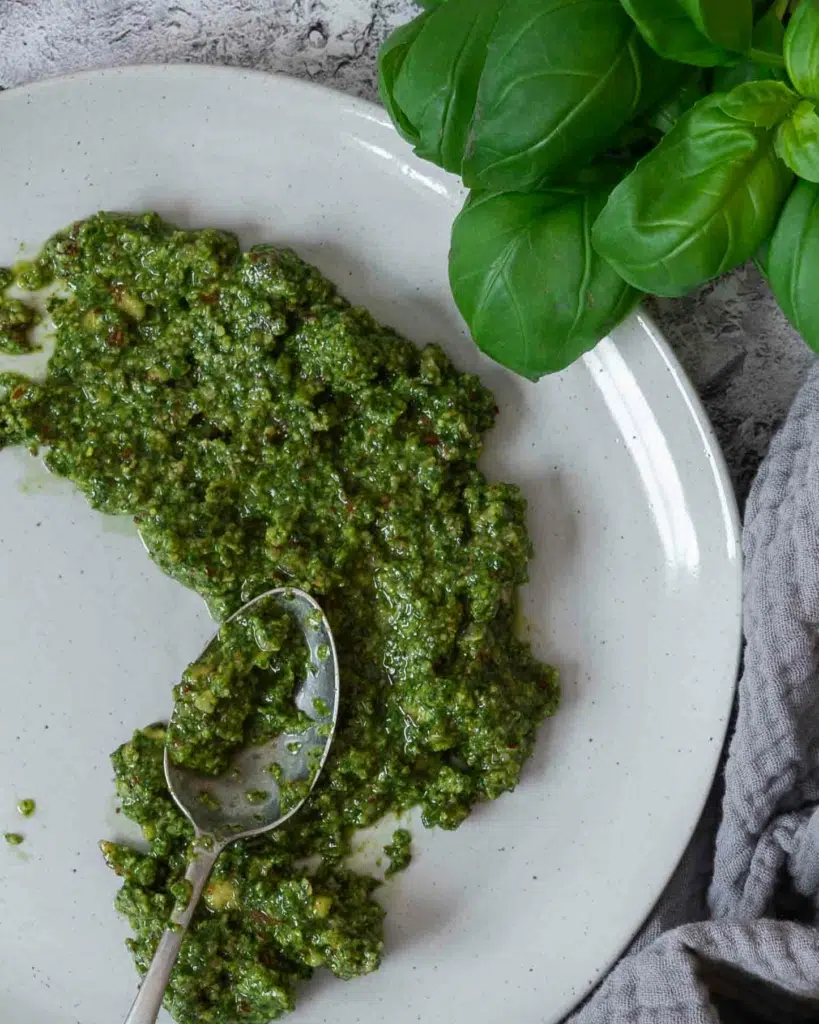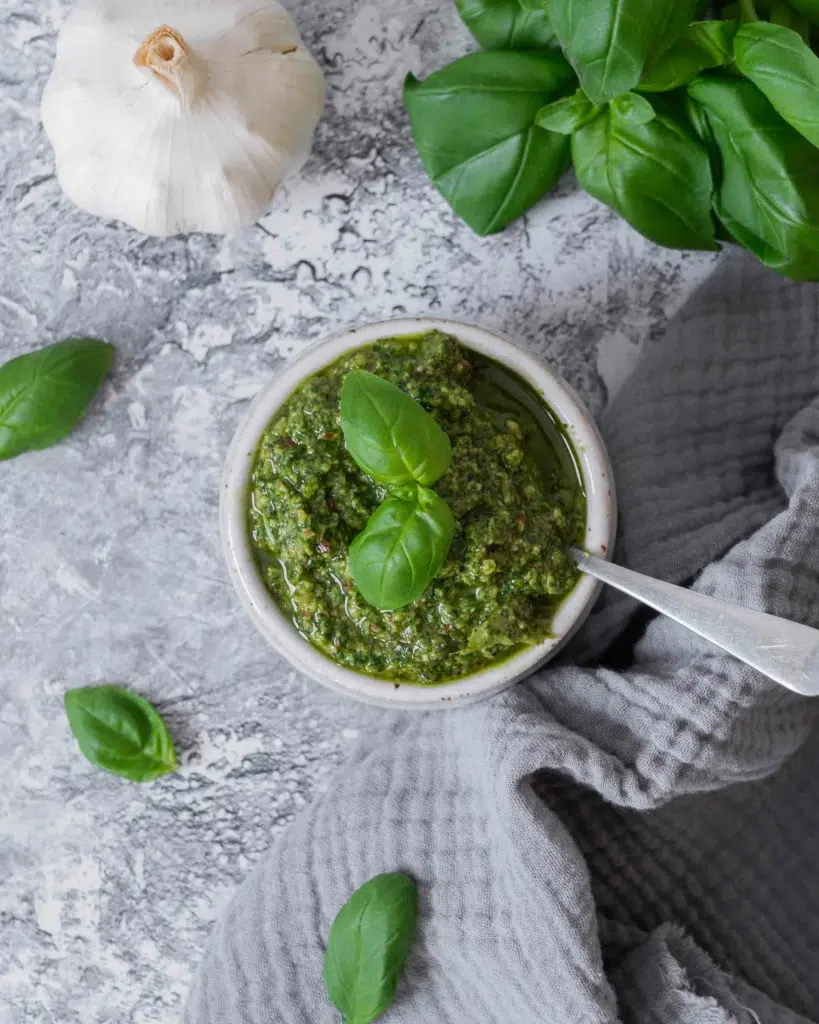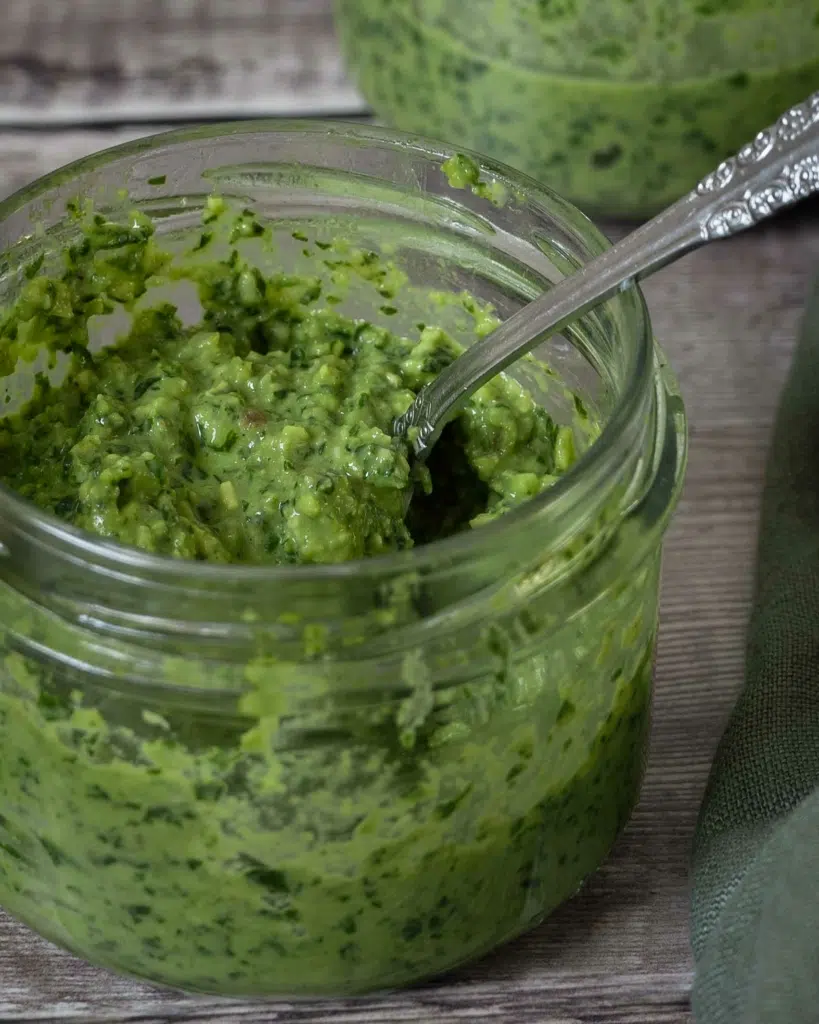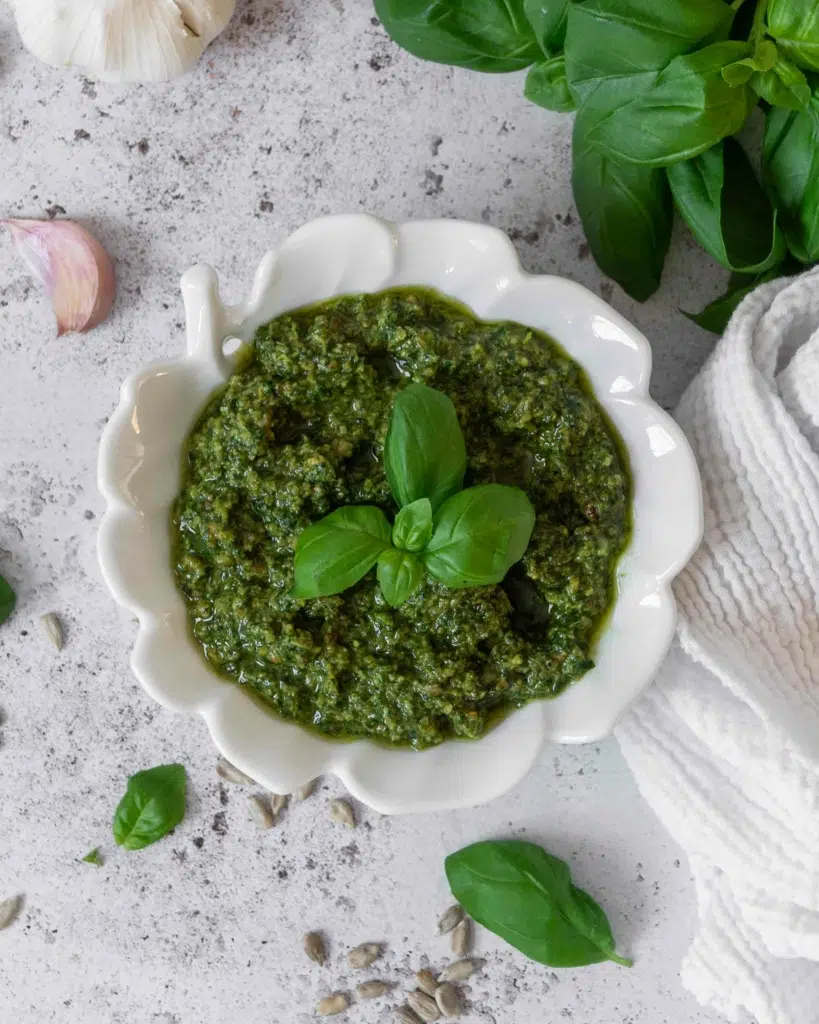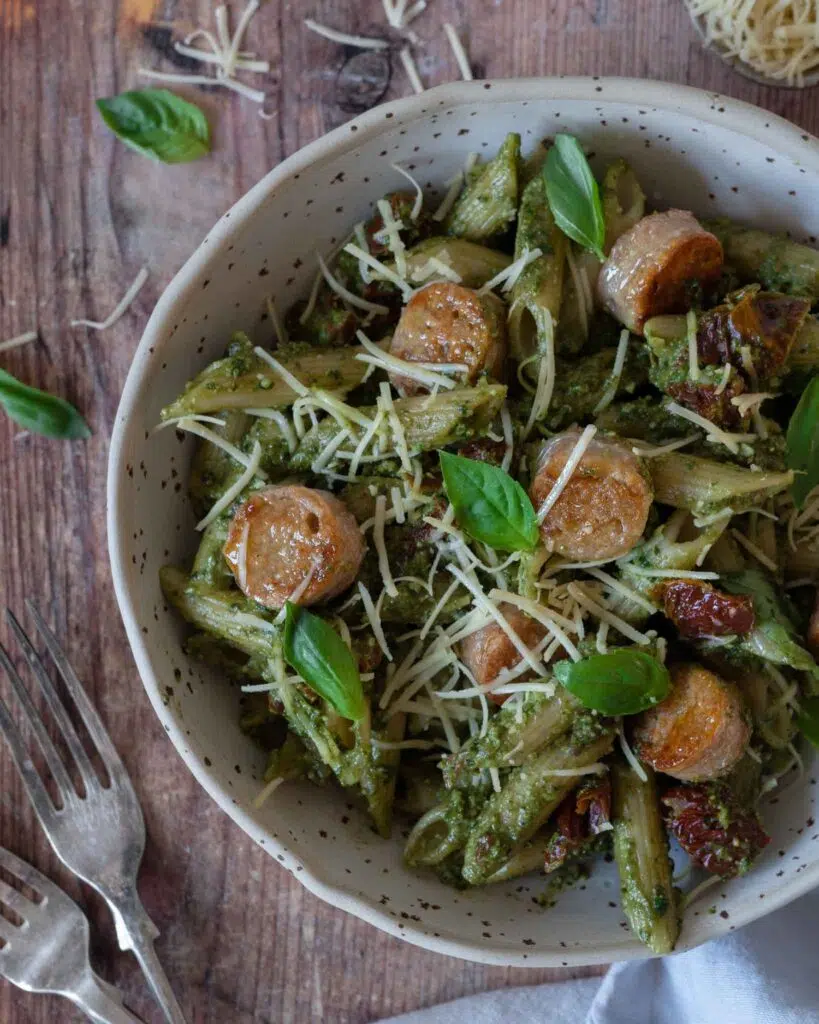When you buy through our links, we may earn a commission. Learn more.
Homemade dairy free nut free pesto that’s ready in just 5 minutes and is as vibrant and flavoursome as a traditional version! Read on to discover our top tips for creating a simple nut-free pesto that’s also dairy free and vegan.
Yes, it’s possible to make pesto that’s nut free and dairy free but with all of the creamy, cheesy, nuttiness of a traditional version! We’re showing you how in this recipe.
We use a special blend of ingredients to replicate the flavours of a classic pesto and we’re walking you through the steps of making this simple homemade pesto without nuts. You can even freeze it into portions to use later.
This nut free dairy free pesto is packed with flavour; with a beautiful savoury balance of herbs, garlic and saltiness. Use this vegan basil pesto to elevate your dinners – stir it into pasta and soup or drizzle it over your pizzas and salads.
Quick Links:
- The written recipe
- The video recipe
- Success tips
- Step by step instructions
- What can you eat with pesto?
- FAQs
- Other flavoursome pesto recipes like this one
Did you know?
Pine nuts are one of the staple ingredients in a traditional pesto. Despite the name, did you know that they are the edible seeds of the pine tree (Allergy UK)? Some people do have an allergy to pine nuts, therefore this recipe can be made with either pine nuts or sunflower seeds, depending on your preference and dietary requirements.
In addition to this Nut Free Pesto recipe, we’ve got several other vegan pesto recipes, including:
Click the easy vegan pesto recipe name above to head straight to the recipe, if you’re looking for these alternatives.
What is Pesto?
Famous in Italian cuisine, pesto is a sauce is known for it’s bright green colour and fresh, herby flavour. It is believed to have originated from the Liguria region of Northern Italy, specifically the port of Genoa.
Traditionally pesto is made by blending fresh basil, garlic cloves, pine nuts, parmesan (or pecorino cheese) and olive oil.
Success Tips
- Use high quality ingredients. To make the freshest and most flavoursome pesto you’ll want to use fresh basil leaves and a good quality extra virgin olive oil. Why not make a big batch in the summer when basil is in season and at it’s best?
- Toast the pine nuts/sunflower seeds. Despite the name, did you know that pine nuts are the edible seeds of the pine tree (Allergy UK)? Some people do have an allergy to pine nuts, therefore this recipe can be made with either pine nuts or sunflower seeds, depending on your preference and dietary requirements. Whether you choose pine nuts or sunflower seeds, make sure you pick a toasted version as this intensifies their nutty flavor. If your pine nuts/sunflower seeds are not already toasted, follow the instructions provided in the recipe card.
- Would you like a spread or a sauce? The consistency of this dairy free nut free pesto can be adjusted to suit – if you’d like a thick and spreadable pesto, make it as per the recipe. It can also make a versatile sauce! If you’d like a nut-free vegan pesto sauce that you can drizzle, add a little more water until it reaches the perfect consistency.
- How to refrigerate pesto. To refrigerate your homemade pesto, place it in an airtight container with either a thin layer of olive oil on top, or a layer of eco-cling film (with the film touching the top of the pesto) before adding the lid. This helps to preserve the colour. Store for up to 3 days in the fridge.
- How to freeze pesto. This homemade pesto can be frozen into single-serve portions using an ice cube tray, making it a convenient for weeknight dinners. Once frozen, pop out the pesto cubes and store them in an airtight container in the freezer for up to 2 months.
How to make this Dairy Free Nut Free Pesto
Read on to find out how to make pesto without nuts, including the best ingredients to use:
Ingredients
Pine nuts or sunflower seeds – toasted is a must for flavour. Pine nuts will create a creamier pesto and are our recommendation if you can eat them and have them to hand.
Fresh basil leaves
Nutritional yeast – the secret ingredient used to add a cheesy flavour to this dairy-free pesto
Olive oil – ideally extra virgin
Garlic – opt for fresh garlic if possible
Lemon juice – fresh or bottled is fine (feel free to add a little lemon zest too if you like)
Seasoning – sea salt and black pepper
Water – used to thin the pesto if you’d like to create a delicious sauce
Optional – dried rosemary (only if using sunflower seeds instead of pine nuts)
Equipment
You’ll need a food processor for this recipe, along with a small frying pan for toasting the pine nuts/sunflower seeds if they are not already pre-toasted.
Steps
Make sure to head to the recipe card below for the full recipe and instructions! Here’s how to make pesto without nuts:
Gather together your ingredients.
Add the toasted pine nuts/sunflower seeds and basil to a food processor along with all of the other ingredients and pulse until combined. Scrape down the sides of the processor bowl and pulse again as necessary.
Tip: If your pine nuts/sunflower seeds are not already toasted, add them to a dry frying pan (no oil) and toast them over a low heat until they are lightly golden. This will take around 10 minutes.
Tip: If you’re using sunflower seeds, they can take longer to break down in the food processor than pine nuts. Continue processing until you create a smooth pesto.
Store the pesto in the refrigerator in an airtight container for up to 3 days. To preserve the colour as best as possible, cover the pesto with a thin layer of olive oil or eco cling film (with the film touching the top of the pesto) before adding an airtight lid.
Alternatively, you can freeze the pesto into ice cube trays to create single-serve portions that will last for 2 months in the freezer. Stir a cube into a pan of warm pasta for a quick and easy weeknight meal!
What can you eat with this nut-free pesto?
Pesto can be enjoyed with a wide variety of dishes. Here are some different ways you can enjoy this vegan and nut free version of a traditional pesto:
- In pasta sauce. Create a simple pesto pasta or stir it into your favourite pasta sauce.
- Drizzle on pizza. Drizzle the fresh pesto over freshly cooked pizza or use it as a base instead of tomato marinara. Get our recipe for Easy Vegan Pizza Dough here.
- In sandwiches. Brush a cut ciabatta in a little olive oil and then toast it in a frying pan until golden. Top with rocket, fried cherry tomatoes and a drizzle of pesto sauce. Or what about pesto drizzled over tofu scramble? Yum!
- Use as a salad dressing. Add a burst of flavour to your summer salads with this beautifully vibrant nut-free pesto recipe.
- Stir into soup. Brighten up your soup by swirling a spoonful of this pesto on top.
- As a dip. Pair it with breadsticks, crackers and veggie sticks for a party or evening with friends. You might also like this White Bean Hummus recipe.
FAQs
What is dairy free nut free pesto made of?
Our nut free pesto is made using pine nuts*, or sunflower seeds depending on your preference and dietary requirements.
Traditional basil pesto contains dairy in the form of parmesan cheese, which is usually not vegan or vegetarian. To replicate the cheesy flavor of parmesan, we use nutritional yeast which is available in many supermarkets.
Alternatively, you can use store-bought vegan parmesan instead, just make sure it’s one you love the flavor of!
If you prefer not to have a mild cheesy flavor to your pesto, you can omit the nutritional yeast from this dairy free pesto recipe although it does add extra flavor. You may need a little more seasoning so taste and add more as necessary.
* Allergy UK says that pine nuts are the edible seeds of the pine tree (Allergy UK) however some people are also allergic to pine nuts.
How long does pesto last?
Store leftover pesto for up to 3 days in the fridge or up to 2 months in the freezer.
When storing in the fridge, cover the pesto with eco cling film (with the film touching the top of the pesto) or a little extra olive oil before adding an airtight lid. This will help to preserve the colour.
Can I freeze pesto?
Yes, pesto can be frozen for up to 2 months. Add the pesto to silicone ice cube trays and, once frozen, transfer these frozen cubes to an airtight container or freezer bag. Each cube will make a perfect single-serving that can either be added straight to the pan to stir into cooked drained pasta and warm through, or defrosted in the fridge to drizzle over soups and salads.
Loved this dairy free nut free pesto? Here are some other classic pesto recipes to try
I hope you LOVE this recipe for Dairy Free Nut Free Pesto! Please share this recipe with someone you think will enjoy it because it’s our goal to encourage as many people as possible to try plant based eating.
If you make this recipe, please leave a comment and star rating below – this provides helpful feedback to both me and other readers. If you want more delicious vegan recipes be sure to subscribe to the A Vegan Visit newsletter. We’d also love for you to join the AVV community on Youtube, Tiktok, Instagram, Pinterest and Facebook.
The Video Recipe:
The Written Recipe:

Nut Free Pesto (5 Minute Dairy Free Vegan Recipe)
Ingredients
- 40 g pine nuts or sunflower seeds (toasted*)
- 60 g fresh basil leaves
- 7 g nutritional yeast
- 50 ml olive oil (extra-virgin ideally)
- 3 small cloves garlic (minced (or 2 medium cloves))
- ½ tbsp lemon juice
- 1/4-1/2 tsp salt
- ⅛ tsp ground black pepper
- up to 40 ml of water to loosen the mixture
- if you’re using sunflower seeds also add 1/4 tsp dried rosemary (omit if you’re using pine nuts)
Equipment
- Food Processor
Instructions
- Add all of the pesto ingredients to a food processor, starting with 1/4 tsp salt.Pulse until combined, scraping down the sides of the processor bowl as necessary before blending again. Add a little water as needed during the blending process to achieve the desired consistency for your pesto (thick for spreadable, thinner for a sauce).Taste and add more salt if desired.Note: If your pine nuts/sunflower seeds are not already toasted then add them to a dry (no oil) frying pan. Toast them over low heat, stirring occasionally, until lightly golden - this should take around 10 minutes.Note: If you are using toasted sunflower seeds, they can take a little longer to break down in the food processor than pine nuts so make sure to blend for long enough to create a smooth sauce.40 g pine nuts or sunflower seeds, 60 g fresh basil leaves, 7 g nutritional yeast, 50 ml olive oil, 3 small cloves garlic, 1/2 tbsp lemon juice, 1/4-1/2 tsp salt, 1/8 tsp ground black pepper, up to 40 ml of water to loosen the mixture, if you’re using sunflower seeds also add 1/4 tsp dried rosemary
- To store the pesto, add it to a dish and cover it in eco cling film (with the film touching the top of the pesto) and then add an airtight lid. Alternatively, you can add a thin layer of olive oil on top of the pesto instead of using cling film, before adding an airtight lid.
- Store the pesto in the fridge, or freeze using an ice cube tray for single servings that you can use for a quick meal.

